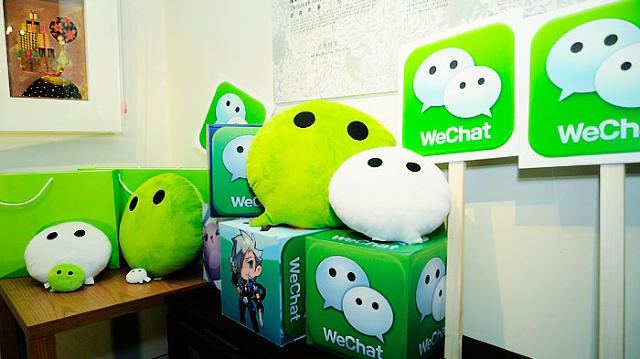Why China’s Biggest App Has Sputtered Everywhere Else
Last week, my colleague Steven Millward wrote an excellent piece about China’s most popular social app, WeChat and how, despite the money owner Tencent poured into marketing via stars like Lionel Messi, the app simply hasn’t caught on outside of China. In virtually every market Tencent targeted, WeChat is still playing second fiddle to Facebook’s apps.
Why? There are a lot of market-specific reasons if you do a deep dive. But broadly, I think there are three big mistakes Tencent made with WeChat in its overseas expansion, and—not coincidentally—they’re mistakes that Chinese companies make a lot when they launch internationally.
1. Late To The Party
The first and most obvious reason: WeChat hit most international markets in 2012 or even later, well after other chat apps had gotten established there. Tencent tried to make up for that with an expensive, star-studded marketing push, but marketing doesn’t work that well for chat apps. Ultimately, if your friends use a chat app, you’re probably going to use it too. If your friends don’t use an a chat app, you’re probably not going to use it regardless of how many Messi ads you see.
By the time WeChat was launched internationally, there was already a dominant chat app in most markets. It varied from place to place. In Indonesia, it was Blackberry Messenger. In the U.S., it was WhatsApp. But the core problem was the same: People’s friends were already using a chat app that wasn’t WeChat.
2. China-First Approach
WeChat’s second mistake was not offering people any significant reason to switch from whatever chat app they were already using.
In China, Tencent didn’t make this mistake. WeChat’s main competition in the early days was another Tencent app, QQ, but that was a holdover from the days of PC-based instant messaging. WeChat was engineered for the mobile world, and Tencent quickly turned it from a simple messaging app into an all-in-one mobile platform on which Chinese users could do everything from order a pizza to play their favorite games.
But while Tencent talked a good game about keeping things equal, those same features came to international users more slowly, if they ever came at all. Even now, in mid-2016, I still can’t order any food through my American WeChat app. I can’t book an Uber or control my smart TV with it. Four years after its international launch, the global version of WeChat is still only a pale shell compared to what’s available in the Chinese version.
To be fair, it’s hard to blame Tencent for this, given the size of the Chinese market, the success the app has enjoyed there, and the ease with which Tencent can link the app with some of its other businesses (like mobile gaming). To give the global app the same functionality as the domestic app would require Tencent to negotiate thousands of partnerships with businesses across the world—an exhausting and expensive proposition, to be sure.
But still, the company has clearly put China first in its WeChat development plans. Is it really any surprise that it’s seen far more success in China than in other markets, where the product it offers feels like a stripped-for-parts skeleton when compared with the Chinese original?

3. Poor Localization
Another reason for WeChat’s success in China was that Tencent understood China’s market very well. Thanks to a decade of data from QQ as well as a lot of information about mobile habits from the company’s mobile game dominance, Tencent knew better than anyone what Chinese users wanted out of a chat app, and it delivered exactly that with WeChat, slowly morphing it from a fun social tool into an all-in-one mobile hub for almost every aspect of life in China.
But Tencent hasn’t shown the same level of care in adapting its product for international markets. As mentioned above, the global WeChat app doesn’t offer nearly as much as the Chinese version does, but beyond that there’s another failure: It wasn’t seriously tweaked to adapt to the user needs of the local markets it was launching in.
Again, using my own American WeChat as an example: Imagine my wife sends me a funny picture on WeChat. I want to tweet it out to all of my followers. That’s a pretty typical thing an American user might want to do with an image, but as far as I can tell, it’s not possible from the American WeChat app. I can share the picture with other WeChat users, or I can add it to my WeChat favorites, but that’s pretty much it.
Another example: stickers. WeChat allows users to buy and download sticker packs to spice up their conversations, but it’s clear that stickers tailored toward Chinese users are the priority. When I search WeChat for some of the things Americans might like to put into their chats—baseball, American football, independence day—I find absolutely nothing. When I search for “Spring Festival” in Chinese, I find multiple sticker packs and dozens of other related stickers. And it’s not just the U.S. that’s getting the short end of the sticker straw. A search for “carnival”—Brazil’s most famous festival—also turns up “No result.” So does a search for “Ramadan.”
The U.S. may not have been an important target in WeChat’s international expansion, but Brazil certainly was, and Indonesia was as well. Yet even something as simple as sticker availability seems to betray that Tencent wasn’t putting as much effort into localizing WeChat in each international market as it could have been.
Of course, none of this is likely too upsetting to Tencent executives. I’m not sure how much all of those Messi ads cost, but the app does have 762 million active users, so its dominance in the Chinese market is nothing to sneeze at, even if it hasn’t achieved the global results Tencent was hoping for.
Still, these three mistakes are things we see again and again when Chinese companies attempt international expansion, with predictable results. The moral of the story: Get out of the gate quickly, take it as seriously as you take your home market, and don’t half-ass the localization unless you want the results you reap to look half-assed, too.
This story originally appeared at TechInAsia. Follow Charlie and TechInAsia on Twitter.
Fast Company , Read Full Story
(52)



